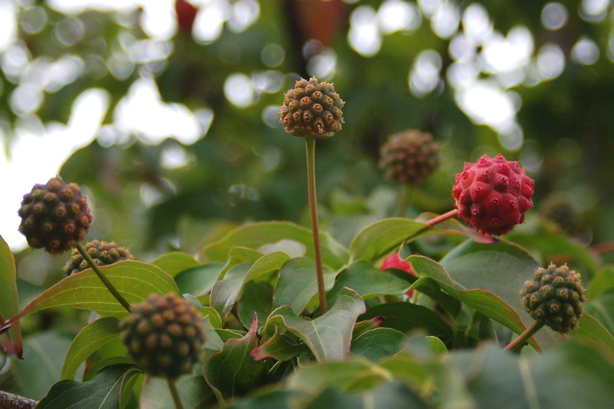
Last May, 2007, I started to notice these sort of muted, creamy, almost dogwood-shaped blossoms, practically at eye level as I walked down the slightly steep sidewalk from West Burnside to our apartment building. As time passed, I snapped these photos. I lucked up on finding out what the tree's name is, with the help of Google and Marsha at work--she's quite the gardener.

July, 2007

August, 2007.
Kousa Dogwood
From Wikipedia, the free encyclopedia
The Kousa Dogwood (Cornus kousa or Benthamidia kousa), also known as the Japanese Flowering Dogwood (Yamaboushi (ヤマボウシ, Yamaboushi?)), is a small deciduous tree 8-12 m tall, native to eastern Asia. Like most dogwoods, it has opposite, simple leaves, which are 4-10 cm long.
The tree is extremely showy when in flower, but the "flowers" are actually showy white bracts below the cluster of inconspicuous yellow-green flowers. The flowering is in late spring, weeks after it leafs out. It has a relatively upright habit, unlike the closely related Flowering Dogwood (Cornus florida) of eastern North America, which has a sprawling habit. It also differs from that in flowering about a month later, and in having pointed (not rounded) flower bracts.
The fruit is a globose pink to red compound berry 2-3 cm diameter, though these berries tend to grow larger towards the end of the season and some berry clusters that do not fall from the tree surpass 4 cm. It is edible; though lacking any interesting flavour to humans, it is taken by birds.
There are two varieties:
* Cornus kousa var. kousa. Leaves 4-7 cm; flower bracts 3-5 cm. Japan.
* Cornus kousa var. chinensis. Leaves 5-10 cm; flower bracts 4-6 cm. China.
It is resistant to the dogwood anthracnose disease, caused by the fungus Discula destructiva, unlike Flowering Dogwood, which is very susceptible and commonly killed by it; for this reason, Kousa Dogwood is being widely planted as an ornamental tree in areas affected by the disease. A number of hybrids between Kousa Dogwood and Flowering Dogwood have also been selected for their disease resistance and good flower appearance.

8 comments:
Kousa dogwood - one of the very prettiest on this earth.
I'm on the East Coast (CT) and our kousa are either in full bloom right now or just over the hill. Must be the two varieties you've mentioned. Whatever, they are simply lovely.
Your W post - Wonderful - is just that, Wonderful!
My variegated dogwood bushes have dogwood anthracnose disease and die back after reaching some maturity in several years. Or parts of them die and are cut out. It is a constant battle with cloning new plants from the old but I am slowly looking for replacements with more wildlife value and am trying out arrowwood as it offers flowers and berries and grows quickly with no diseases that I know about.
Your photograph is very nice and a welcome sight to see, for me.
Pretty! Great detail.
Hi Lynette, fantastic pictures.
Very nice photos! We have some dogwoods in bloom near me, I should get some photos before the blossoms are gone.
that first photo is so great. what sort of camera do you use?
Olga - GORGEOUS images! you are a wonderfully talented lady! I'm glad I found your site, I have always had a fascination with your part of the country - I'll be back very often!
Jerry in Tampa
Interesting post and lovely images!
Thank you! :-)
Post a Comment